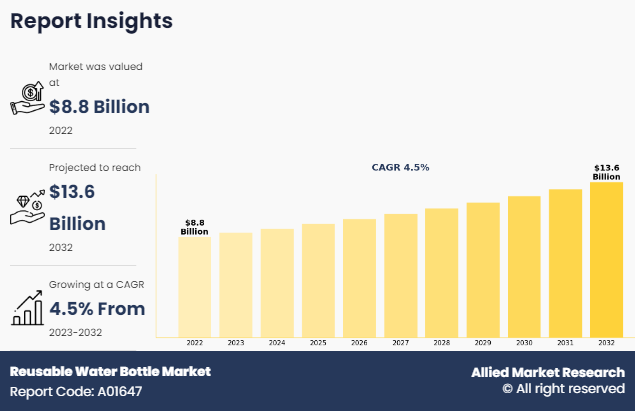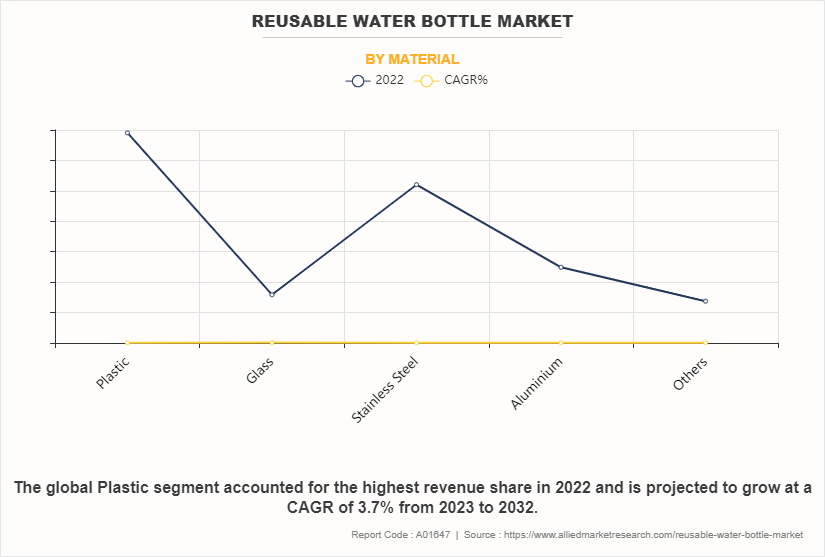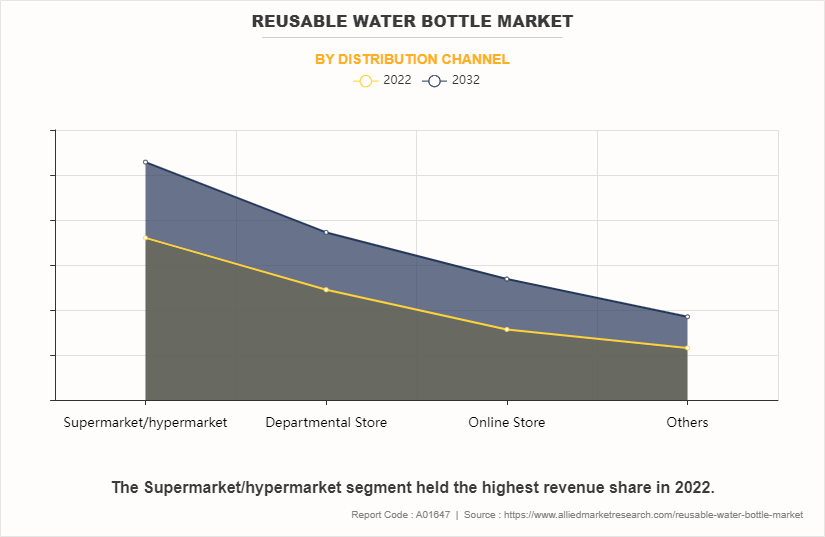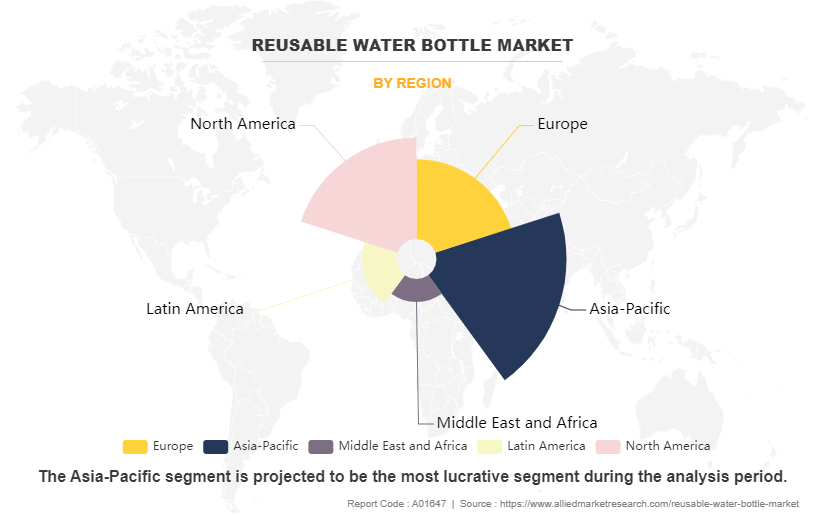Reusable Water Bottle Market Research, 2032
The global Reusable Water Bottle Market size was estimated at USD 8.7 billion in 2022 and is projected to reach USD 13.5 billion by 2032, growing at a CAGR of 4.5 % from 2023 to 2032. The reusable water bottle market is witnessing strong growth, driven by rising environmental awareness and increasing efforts to reduce single-use plastic waste. Consumers are increasingly shifting toward sustainable hydration solutions, encouraged by government regulations and corporate sustainability initiatives. In addition, the popularity of fitness and wellness trends has elevated the demand for durable and stylish bottles that cater to both every day and active lifestyles. Material innovations such as stainless steel, glass, and BPA-free plastics are also contributing to product differentiation and market expansion. However, price sensitivity in some regions and the availability of low-cost disposable alternatives may restrain full market penetration.
The Reusable Water Bottle Market in Asia Pacific held a significant share of over 35% in 2022.
The Reusable Water Bottle industry in the South Korea is expected to grow significantly at a CAGR of 5.2% from 2023 to 2032.
By material, the stainless-steel segment is the second largest segment in the market and accounted for the revenue share of about 30% in 2022.
By distribution channel, the online store segment is expected to be the fastest growing segments in the market during the forecast period.
Market Size & Forecast
2022 Market Size: USD 8.7 Billion
2032 Projected Market Size: USD 13.5 Billion
CAGR (2023-2032): 4.5%
Asia Pacific: Largest market in 2022
Middle East and Africa: Fastest growing market during forecast period

A reusable water bottle is a container that can carry liquids, usually water, and is meant to be used repeatedly over time. These bottles are made of strong materials like metal, glass, polymers, or BPA-free plastics, assuring their lifespan and robustness to frequent use. They serve as environmentally responsible substitutes for one-time-only plastic bottles, supporting sustainable consumption behaviors by lowering plastic waste output and minimizing the environmental effect of disposable containers. Reusable water bottles are available in a variety of sizes, styles, and shapes to meet the varying customer tastes and lifestyle demands. They frequently have useful features such as resistance to leak seals, ergonomic layouts for ease of transport, and low reactivity with various beverages.
Key Takeaways
In 2022, on the basis of material, the plastic segment was the highest contributor to the reusable water bottle market.
According to distribution channel, the supermarket/hypermarket segment generated the highest revenue in 2022 and is expected to grow at a substantial rate during the forecast period.
By region, Asia-Pacific was the major revenue contributor in 2022 and is estimated to grow at a significant CAGR during the forecast period.
Market Dynamics
The increase in environmental concern is considerably driving the reusable water bottle market demand. As worldwide awareness of the harmful effects of plastic waste on ecosystems grows, customers increasingly looking for environmentally friendly alternatives to disposable plastic items. The increased awareness has fueled consumers to shift from single use/disposable plastic water containers to reusable drinking bottles. Individuals prefer to invest in sustainable water bottles made from resources such as metals, recycled glass, and recycled plastic. The increased usage of reusable bottles is expected to additionally decrease plastic waste and help reduce environmental pollution. Furthermore, tough legislative efforts adopted by governments globally to reduce single-use plastic usage have sped the move to sustainable alternatives. As a result, as consumer preference for green goods rises, the reusable water bottle business is expected to witness long-term growth, fueled by consumers, businesses, and government officials working together to promote an environment-friendly future.
The increase of corporate sustainability programs has emerged as a crucial driver for the reusable water bottle market. Recognizing their obligation to environmental management and the need to decrease the amount of carbon they produce; a growing percentage of businesses are incorporating sustainability concepts into their business practices and employee benefit programs. As part of these measures, several companies are distributing reusable water bottles to all their staff as a sustainable substitute for disposable plastic bottles. Companies that promote the use of reusable water bottles not only showcase their dedication to environmental conservation but also help to reduce plastic waste output on their campus.
Furthermore, these campaigns frequently go beyond within-company procedures and incorporate corporate gifting, advertising activities, and collaborations with sustainability-focused organizations, thereby increasing the exposure and acceptance of reusable water bottles. As corporate sustainability gains momentum as a business necessity, the demand for reusable water bottles is expected to skyrocket, fueled by the combined efforts of firms seeking to incorporate ecological consciousness into their corporate culture.
The high cost associated with reusable water bottles serves as a notable growth restraint for the market. While these bottles offer long-term savings compared to single-use plastic alternatives, their initial upfront cost may deter price-sensitive consumers from making the switch. Reusable water bottles, particularly those made from premium materials such as stainless steel or high-quality glass, often command a higher price point due to their durability, design, and eco-friendly features. This elevated cost can pose a barrier to adoption, especially for individuals or communities with limited disposable income. Moreover, when compared to the inexpensive option of single-use plastic bottles, the perceived value proposition of reusable alternatives may not always outweigh the immediate financial considerations for some consumers.
As a result, despite the long-term environmental and economic benefits of reusable water bottles, the high initial cost remains a significant factor constraining market growth, necessitating efforts to address affordability concerns through pricing strategies, subsidies, or incentives to encourage wider adoption.
The existence of substitutes is a significant challenge faced by the reusable water bottle market. Despite increasing recognition of the detrimental effects of disposable plastic containers and the many advantages of reusable options, disposable options' sustained prevalence and accessibility pose an important obstacle to market adoption. In many areas, single-use plastic bottles are still widely available and inexpensive, often dominating the allure of reusable alternatives. Furthermore, grocery stores, kiosks, and event venues that primarily stock disposable options add to the widespread consumer preference for disposable bottles. Furthermore, in areas with inadequate facilities for refilling or sanitizing reusable bottles, individuals perceive these to be less handy or feasible, thus limiting their acceptance.
To overcome this barrier, significant efforts are required to increase the accessibility and availability of reusable water bottles via activities such as extending distribution networks, raising public awareness, and motivating businesses to emphasize sustainable options. By resolving these issues, the reusable water bottle market may progressively overcome the barrier provided by an abundance of alternatives and reach its full development potential.
The availability of unique designs in reusable water bottles is attracting the attention of consumers and acting as a growth opportunity for the reusable water bottle market. As consumer preferences shift and environmental consciousness becomes more important, there is a rising desire for creative and adaptable reusable water bottles that meet a variety of demands and interests. Manufacturers are harnessing advances in the study of materials, design technology, and customer insights to create goods with more features, such as enhanced insulation, ergonomic designs, customizable choices, and unique lid mechanisms. Furthermore, the inclusion of value-added features such as embedded filtration systems, smart technological capabilities, and modular components broadens the attractiveness and usability of reusable water bottles. Furthermore, customization choices, such as personalized logos, colors, and patterns, let customers show their personality while also supporting conservation.
Collaborations between companies and designers, in addition to partnerships with sustainability-focused organizations, provide chances for market distinctiveness and collaboration. Companies may capitalize on this growth potential by constantly inventing and broadening their product offerings, attracting new customers, and driving market expansion while promoting sustainability goals.
The launch of educational programs in emerging markets provides a substantial potential opportunity to expand the reusable water bottle market. As worldwide consciousness regarding environmental sustainability grows, particularly in rapidly developing economies, there is a growing acknowledgment of the significance of decreasing plastic waste and implementing more eco-friendly methods. Educational programs are critical for teaching and strengthening people, organizations, and institutions regarding the harmful effects of disposable plastics and the advantages of recyclable options such as water containers. These efforts promote environmental stewardship by informing people about the necessity of recycling, conservation, and responsible consumption. Furthermore, educational programs ought to highlight the positive health effects of utilizing reusable water bottles, including lowering exposure to dangerous chemicals contained in throwaway plastics.
Companies participating in the reusable water bottle industry can use collaborations with government organizations, non-profit organizations, and educational institutions to create awareness, extend their customer base, and promote market growth in emerging nations. Investing in training and advocacy initiatives allows participants to contribute to good behavior modification and environment-friendly growth while also capitalizing on new market expansion prospects.
Segments Overview
The reusable water bottle market is segmented into material, distribution channel, and region. Depending on material, the market is segregated into plastic, glass, stainless steel, aluminium, and others. On the basis of distribution channel, it is fragmented into supermarket/hypermarket, departmental store, online store, and others. Region wise, it is analyzed across North America (the U.S., Canada, and Mexico), Europe (Germany, UK, France, Italy, Spain, and rest of Europe), Asia-Pacific (China, Japan, India, Australia, South Korea, and rest of Asia-Pacific), Latin America (Brazil, Argentina, and rest of Latin America), and Middle East & Africa (Saudi Arabia, South Africa, United Arab Emirates, and rest of Middle East & Africa).
By Material
According to the reusable water bottle market statistics, on the basis of material, the plastic segment dominated the market in 2022 and is expected to continue this trend during the forecast period. Plastic is a common raw material for making reusable water bottles due to its light weight, convenience, and ease of production. Polyethylene terephthalate (PET) is one of the most often used materials for water bottles.

By Distribution Channel
Depending on distribution channel, the hypermarkets/supermarkets segment led the market in 2022 and is expected to maintain this trend during the reusable water bottle market forecast period. The increased demand for ecologically friendly & sustainable water containers and the exhaustive product offerings of unique reusable water bottles in the hypermarkets is one of the main factors boosting the sales.

By Region
Region wise, Asia-Pacific dominated the market in 2022 and is expected to dominate the market during the forecast period. The increasing environmental awareness and concerns about plastic pollution are driving consumers toward sustainable alternatives such as reusable water bottles in Asia-Pacific. Governments and environmental organizations in many countries are also implementing policies and campaigns to promote sustainable living, further boosting demand.

Competitive Analysis
Players operating in the reusable water bottle market have adopted various developmental strategies to expand their reusable water bottle market share, increase profitability, and remain competitive in the market. The key players profiled in this report include SIGG Switzerland AG, GmbH, CamelBak Products, LLC, Klean Kanteen, Contigo, Aquasana Inc., Hydaway, Nalgene, Swell, and Ocean Water.
Recent Developments in the Reusable Water Bottle Market
- In February 2021, Hydaway launched a new version of its collapsible bottle that fits in the pocket. It is available in two sizes, 25 ounces and 17 ounces, and features a standard cap lid and a useful spout lid. The bottle is made from BPA-free plastic and silicone.
- In August 2020, Nalgene launched a new line of reusable water bottles under the brand name Nalgene Sustain. The water bottles are made of 50% recycled content and waste plastic.
What are the Leading Companies in Cybersecurity
- This report provides a quantitative analysis of the market segments, current trends, estimations, and dynamics of the reusable water bottle market analysis from 2022 to 2032 to identify the prevailing reusable water bottle market opportunities.
- The market research is offered along with information related to key drivers, restraints, and opportunities.
- Porter's five forces analysis highlights the potency of buyers and suppliers to enable stakeholders make profit-oriented business decisions and strengthen their supplier-buyer network.
- In-depth analysis of the reusable water bottle market segmentation assists to determine the prevailing market opportunities.
- Major countries in each region are mapped according to their revenue contribution to the global market.
- Market player positioning facilitates benchmarking and provides a clear understanding of the present position of the market players.
- The report includes the analysis of the regional as well as global reusable water bottle market trends, key players, market segments, application areas, and market growth strategies.
Reusable Water Bottle Market Report Highlights
| Aspects | Details |
| Market Size By 2032 | USD 13.6 billion |
| Growth Rate | CAGR of 4.5% |
| Forecast period | 2022 - 2032 |
| Report Pages | 230 |
| By Material |
|
| By Distribution Channel |
|
| By Region |
|
| Key Market Players | Klean Kanteen, Aquasana Inc., Contigo, Ocean Water, SIGG Switzerland AG, GmbH, Tupperware Brands Corporation, Hydaway, Nalgene, S’well, CamelBak Products, LLC |
Analyst Review
According to the CXOs, the key trends in the market are the growing consumer awareness of ecological responsibility and the negative consequences of single-use plastics, which resulted in a move toward eco-friendly alternatives such as reusable water bottles. Furthermore, the growing concentration on personal wellness and physical activity is driving the popularity of reusable water bottles as people attempt to stay hydrated during the day. In addition, advances in manufacturing and design have resulted in the creation of inventive, long-lasting, and visually appealing reusable bottles, which has fueled the market growth.
Government programs and legislation targeted at minimizing plastic waste are establishing an atmosphere that encourages the use of reusable alternatives. Subsidies, rebates, and prohibitions on disposable plastics are driving consumers and companies to choose reusable alternatives. Furthermore, the growth of e-commerce platforms has increased the popularity of reusable water bottles, enabling producers to target emerging markets and demographics. Moreover, agreements between beverage businesses and reusable bottle makers are expanding distribution channels and encouraging the usage of refillable bottles. Finally, the growing popularity of outdoor recreation and travel is driving the demand for long-lasting and reusable water bottles, providing a potential opportunity for market participants to cater to this specialized sector. Overall, with changing consumer tastes and supporting regulatory structures, the reusable water bottle market is positioned for long-term development and expansion in the years ahead.
The reusable water bottle market was valued at $8,778.5 million in 2022 and is projected to reach $13,549.0 million by 2032, registering a CAGR of 4.5% from 2023 to 2032.
The reusable water bottle market registered a CAGR of 4.5% from 2023 to 2032.
Raise the query and paste the link of the specific report and sales executive will revert with the sample.
The forecast period in the reusable water bottle market report is from 2023 to 2032.
The top companies that hold the market share in the reusable water bottle market include Aquasana Inc., Hydaway, Nalgene, S’well, and Ocean Water.
The reusable water bottle market report covers segmentation based on material and distribution channel.
Region wise, Middle East and Africa is estimated to register the highest CAGR of 6.4% from 2023 to 2032.
Post-COVID-19, the reusable water bottle market is witnessing new heights of growth and is recovering from its losses. Increasing consumer consciousness toward plastic recycling and environmental sustainability is influencing the growth of the reusable water bottle market.
Loading Table Of Content...
Loading Research Methodology...



